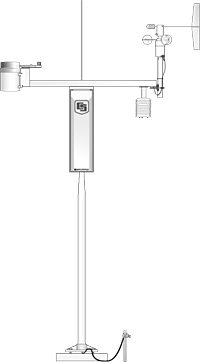
Aperçu
For turf grass water management applications, Campbell Scientific’s T.Weather T107 station and Toro’s Central Irrigation and Control System automatically monitor meteorological conditions that affect turf grass water consumption. This information is used by the Central Irrigation System to analyze current irrigation requirements.
Lire la suiteImages

Fichiers 3D/CAD :
Description technique
Our T107 station consists of meteorological sensors, an aluminum 3-m pole, and an environmental enclosure that houses a CR1000M module and a 7-Ahr sealed rechargeable battery. The battery is recharged via ac power or a 10-W solar panel. Sealed circular connectors are provided on the outside of the enclosure to simplify sensor hookup.
Meteorological sensors included with the T107 are the CS305-ET Solar Radiation Sensor, HMP60-ETS Air Temperature and Relative Humidity Probe, TE525-ET Tipping Bucket Rain Gage, and either the 034B-ETM Wind Set or WindSonic1-ETM 2-D Sonic Wind Sensor.
Phone or short haul modems are used to transfer hourly weather data between the weather station and a central computer. The central computer calculates ETo and programs each controlling satellite with the appropriate irrigation cycles.
Compatibilité
Replacement sensors for the T107 have a -ET or -ETM suffix.
Spécifications
| -NOTE- |
The T107 has components that have their own specifications. To review these specifications, refer to the appropriate products below: |
Documents à télécharger
FAQ
Nombre de FAQ au sujet de(s) T107: 4
Développer toutRéduire tout
-
Yes, but the following conditions must be met:
- The station has to use IP communications (through an Ethernet, Wi-Fi, or cellular modem connection).
- The programming on the weather station’s datalogger has to be changed to produce the data in the appropriate format and communicate the data to the Weather Underground website.
-
Si VisualWeather est utilisé avec les ET107, T107 (Toro), ET106 ou MetData1, et que la station a une configuration standard, la mise en place de la station dans VisualWeather est relativement simple. Sélectionnez la station dans la liste de l'écran Weather Station Network, et la plupart du travail est effectué automatiquement.
Si, toutefois, une station personnalisée, un modèle de station différent ou une variante différente pour l'un des capteurs est utilisée, il est nécessaire de configurer une station personnalisée dans les écrans de configuration du réseau de stations météo - Weather Station Network. Dans l'écran de sélection de la station - Station Selection , sélectionnez Custom.
Suivez les écrans qui vous demandent les détails de la station. Ensuite, VisualWeather se connectera à la station et obtiendra les noms et les champs des tables de données sur la station où les données sont stockées. Comme les noms et les champs de ces tables sont sans signification pour VisualWeather, un processus de mise en correspondance doit être utilisé pour faire correspondre les champs des tables de données aux champs et aux unités que VisualWeather reconnaît. Ce mappage permet à VisualWeather de créer des écrans et des rapports qui ont un sens.
Comme les tables de données sont souvent identifiées par un numéro et que les champs sont souvent cryptés, le processus de cartographie peut parfois prêter à confusion. Pour cartographier les champs d'une station personnalisée, contactez Campbell Scientific pour obtenir de l'aide.
-
Campbell Scientific recommande le calendrier de maintenance suivant :
- Une fois par semaine : contrôler le cône du pluviomètre et nettoyer le si nécessaire.
- Une fois par mois : contrôler le capteur de rayonnement et nettoyer le si nécessaire.
- Tous les 3 mois : nettoyer l'abri du capteur de température et d'humidité relative.
- Tous les 6 mois à 1 an : remplacer les deux sachets de dessiccant (pn 4905).
- Tous les 1 à 3 ans : remplacer les roulements de l'anémomètre et le relais reed. Demander un numéro de retour à Campbell Scientific (RMA) en consultant la page Réparation et étalonnage.
- Tous les 1 à 3 ans : remplacer le capteur d'humidité (pn 9598).
- Tous les 3 ans : étalonner le capteur de rayonnement Campbell Scientific. Demander un numéro de retour à Campbell Scientific (RMA) en consultant la page Réparation et étalonnage.
- Tous les 5 ans : étalonner le pluviomètre. Demander un numéro de retour à Campbell Scientific (RMA) en consultant la page Réparation et étalonnage.
- Tous les 5 ans : étalonner la centrale d'acquisition de mesure. Demander un numéro de retour à Campbell Scientific (RMA) en consultant la page Réparation et étalonnage.
-
To post data on a website, the data from the station needs to be regularly collected and put into a viewable format. Campbell Scientific offers two software options that can perform scheduled data collection: LoggerNet and VisualWeather.
VisualWeather is a simple solution that can be used either to connect to the station and monitor data or to set up scheduled data collection. VisualWeather also has powerful reporting capabilities that can be automated. If desired, the screens and reports can be transferred via FTP to a user’s website. A sample site is available for viewing. Using a mouse, hover over the Logan_Utah field in the upper left corner of the web page to view the reports we have selected to generate.
LoggerNet can also be used either to connect to the station and monitor data or to set up scheduled data collection. LoggerNet has more power and flexibility than VisualWeather, but it requires more time and knowledge to implement. For example, LoggerNet comes with an RTMC development tool to create a screen similar to the one in VisualWeather and display the data, but LoggerNet requires that the user learn how to use the RTMC software. In addition, LoggerNet has the ability to transfer data via FTP, but the transfer needs to be set up as a task and then scheduled with the LoggerNet Task Manager.